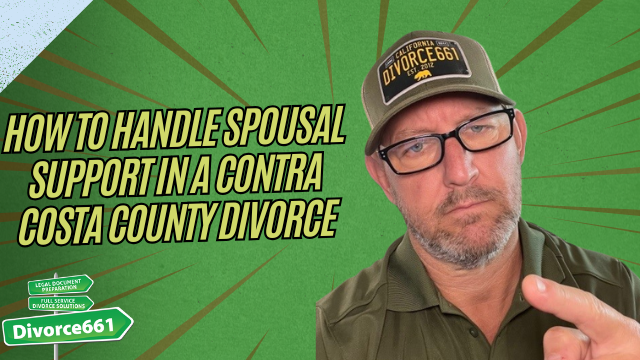How to Handle Spousal Support in a Contra Costa County Divorce
In my video, I walk through how spousal support works in Contra Costa County and across California. I’m Tim Blankenship from Divorce661, and I break down the two types of spousal support, how temporary support is calculated, what influences long-term support, and how you can often reach a fair agreement without going to court.
Quick overview: two types of spousal support
Spousal support in California generally comes in two forms:
- Temporary (pendente lite) support — calculated early in the case to keep both parties afloat while the divorce proceeds.
- Long-term (final) support — decided as part of the final judgment or a settlement agreement, based on a broader set of factors.
Temporary support: straightforward and data-driven
Temporary support is usually the simpler of the two. Courts use tools like Dissomaster (the same software we use at Divorce661) to create an early, standardized calculation based on current incomes and basic deductions. The goal is to stabilize each spouse’s finances while the case moves forward.
Because temporary support relies on the present financial picture, it’s calculated quickly and predictably. That predictability helps both sides understand immediate obligations and reduces financial uncertainty during the process.
Long-term support: the Family Code 4320 factors
Long-term or final spousal support is more nuanced. Courts look at the statutory factors listed in Family Code 4320 to determine whether support should be awarded, for how long, and in what amount. Key considerations include:
- Length of the marriage.
- Each spouse’s earning capacity and marketable skills, including the ability to obtain education or training needed to find employment.
- Age and health of both parties.
- Contributions to the marriage, including homemaking and child care.
- Standard of living established during the marriage.
- Balance of hardships and the paying spouse’s ability to pay.
These factors allow the court — or the parties negotiating an agreement — to look beyond today’s income and evaluate the bigger picture: how the marriage affected each spouse’s financial trajectory and what will be needed to achieve a fair result going forward.
Why contributions to the marriage matter
Contributions that are non-financial — like staying home to raise children, managing the household, or supporting a spouse’s career — are important. The law recognizes that these contributions can limit one spouse’s earning capacity and justify spousal support to address that imbalance.
Real-life example: a 12-year marriage settled without court
Here’s a scenario we recently handled: a Contra Costa couple married for 12 years. One spouse worked while the other stayed home to raise the kids. Instead of litigating, they wanted a fair, private resolution.
We used the 4320 factors to guide negotiations: considering the length of the marriage, the stay-at-home spouse’s interrupted earning history, child-care responsibilities, and both spouses’ health and incomes. That approach led to a customized support plan crafted by agreement, which the court approved without dispute.
This example shows how a thoughtful, factor-based negotiation can produce a fair outcome and avoid the time, cost, and emotional toll of a contested hearing.
You can deviate from court guidelines — if you both agree
One important point: when both parties negotiate in good faith, you can structure spousal support differently than what a formula or court might order. Agreements give you flexibility to account for unique circumstances — for example, lump-sum payments, step-down schedules, or agreed-upon durations that serve both parties’ needs.
That flexibility is one reason many couples choose to settle support issues outside the courtroom: it often leads to more satisfying, workable results for both sides.
Why accurate calculations and proper paperwork matter
Even if you reach an agreement, accurate calculations and correctly filed paperwork are essential. Courts expect clear documentation that reflects income, deductions, and the basis for any support arrangement. Inaccurate or incomplete paperwork can cause delays, reopenings, or even rejection by the court.
Using the same tools and forms the courts use — like Dissomaster for calculations and properly drafted settlement documents — reduces risk and increases the chance your agreement will be approved without problems.
How Divorce661 helps
At Divorce661 we provide a flat-fee divorce service tailored for amicable couples across California. Here’s how we can help with spousal support:
- Use Dissomaster to create accurate temporary and settlement support calculations.
- Apply Family Code 4320 factors to build a fair long-term support plan.
- Draft support agreements that meet Contra Costa court standards.
- File the necessary paperwork and guide you through court approval.
- Provide remote support so you can complete everything from anywhere in California.
Ready to take control of your spousal support situation?
If you want help crafting a fair support agreement or need accurate support calculations and filing, visit divorce661.com to schedule a free consultation. We’ll review your situation, explain options, and help you avoid common pitfalls so you can move forward with confidence.
Facing spousal support can feel overwhelming, but with the right information and support you can reach an outcome that’s fair and workable for your family.
Conclusion
Understanding the difference between temporary and long-term spousal support — and the role of Family Code 4320 — is the first step toward a fair resolution. Whether you use court tools like Dissomaster or negotiate a custom agreement, accurate calculations and clear paperwork are critical. If you want help navigating this process in Contra Costa County, our team at Divorce661 is here to guide you.

